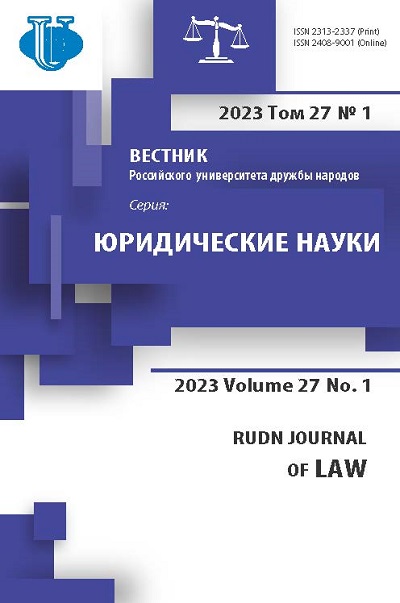Theoretical aspects of identyifying legal personality of artificial intelligence: cross-national analysis of the laws of foreign countries
- Authors: Musina K.S.1
-
Affiliations:
- Peoples' Friendship University of Russia (RUDN University)
- Issue: Vol 27, No 1 (2023)
- Pages: 135-147
- Section: LAW AND DIGITAL TECHNOLOGIES
- URL: https://journals.rudn.ru/law/article/view/34061
- DOI: https://doi.org/10.22363/2313-2337-2023-27-1-135-147
- ID: 34061
Cite item
Full Text
Abstract
Research analyzes the issues of determining the legal status of artificial intellect. As artificial intellect (AI) systems become more sophisticated and play an increasingly important role in society, the arguments that they should have some form of legal personality are becoming increasingly relevant. The research argues that most legal systems could create a new category of legal persons. The issues of innovative trends in law enforcement practice are also in the focus as well as the issues of establishing general provisions on liability for criminal acts committed due to technical failures of artificial intelligence without the presence of anthropogenic participation and intervention. The article presents the results of the relevance of philosophical-legal and ontological analysis not only to a state, but also to the prospective future modifications of artificial intelligence. It outlines the results of a comparative analysis of the laws regulating artificial intelligence in a number of foreign countries along with the results of a retrospective analysis of some historical stages in the development of legal regulation of artificial intelligence.
About the authors
Kamilla S. Musina
Peoples' Friendship University of Russia (RUDN University)
Author for correspondence.
Email: camillamusina2015@mail.ru
post-graduate student of the Department of Theory of Law and State, Law Institute 6 Miklukho-Maklaya str., Moscow, 117198, Russian Federation
References
- Bayern, Sh.J. (2015) The Implications of Modern Business-Entity Law for the Regulation of Autonomous Systems. Stanford Technology Law Review. 19(93), 93-112.
- Coase, R.H. (1937) The Nature of the Firm. Economica. 4(16), 386-405. https://doi.org/10.1111/j.1468-0335.1937.tb00002.x
- Comin, M. (2015) John Dewey and the Welfare state: towards the history of the development of American democracy. Logos. 25 (6), 152-161. (in Russian).
- David, K. (2003) Piercing the Corporate Veil, Financial Responsibility, and the Limits of Limited Liability. Available at: https://ssrn.com/abstract=451520 or http://dx.doi.org/10.2139/ssrn.451520 [Accessed 30th August 2022].
- Gabov, A.V. & Khavanova, I.A. (2018) Evolution of robots and the 21st-century law. Tomsk State University Journal. (435), 215-233. https://doi.org/10.17223/15617793/435/28 (in Russian).
- Gadzhiev, G.A. & Voynikas, E.A. (2018) Can a robot be a subject of law? (search for legal forms to regulate the digital economy). Law: Journal of the Higher School of Economics. (4), 24-48. https://doi.org/10.17323/2072-8166.2018.4.24.48 (in Russian).
- Iwai, K. (1999) Persons, Things and Corporations: The Corporate Personality Controversy and Comparative Corporate Governance (June 1997). American Journal of Comparative Law. 47 (4), 583-632.
- Lvov, D.S., Grebennikov, V.G. & Yerznkyan, B.H. (2000) Institutional analysis of corporate form of enterprise. Economics of contemporary Russia. (3-4), 5-21. (in Russian).
- Naffine, N. (2003) Who are Law’s Persons? From Cheshire Cats to Responsible Subjects. Modern Law Review. (66), 346-367.
- Peter, A. (1979) The Corporation as a Moral Person. American Philosophical Quarterly. 16(3), 207-215.
- Rasaeva, Kh.A. (2019) Institute of rehabilitation in criminal proceedings. Issues of application. RGGU Bulletin. Economics. Management. Law Series. (1), 122-134. (in Russian).
- Solum, L.B. (1992) Legal Personhood for Artificial Intelligences. North Carolina Law Review. 70 (4), 1231-1287. Available at: http://scholarship.law.unc.edu/nclr/vol70/iss4/4? [Accessed 5 August 2022].
- Trainor, S.A. (1994) Comparative analysis of the corporation’s right to self-incrimination. Fordham International Law Journal. 18(5), 2139-2186.
- Turing, A.M. (1950) Computing Machinery and Intelligence. Mind. 59(236), 433-460.
- Vasiliev, A.A. & Ibragimov, Zh.I. (2019) Legal regulation of robotics and artificial intelligence in the European Union. Russian-Asian Legal Journal. (1), 50-54. (in Russian).
- Wallace, R.S. (2009) The Anatomy of ALICE. In: Epstein, R., Roberts, G., Beber, G. (eds.). Parsing the Turing Test. Springer, Dordrecht. pp. 181-210. https://doi.org/10.1007/978-1-4020-6710-5_13
- Ying, H. (2019) Robot Criminal. University of Michigan Law Reform Journal. (52), 487-531. https://doi.org/10.36646/mjlr.52.2.robot
Supplementary files















